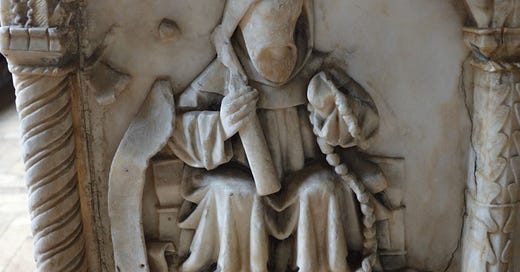Pilgrimage to Lichfield Part 3- Clifton Campville
16th century Bedesmen, 700 year old misericords and a 14th century painting
Church crawling is very like life; you start in a particular direction having an idea of what you will find, only to discover the reality turns out somewhat differently. It can be better or worse than you expect; an open church or one that is closed, despite all the indications to the contrary. Expect the unexpected is always a good motto.
One of the carvings on the most amazing 16th century monument I have ever seen - more to come later in the post
So when we arrived at this church at 1.15pm on the 21st February, I knew it had some unusual things inside, but had no idea of the quality and character of he place, having garnered what little I knew from a one-page summary in Pevsner’s guide.
Pevsner describes this church as having “an uncommonly fine steeple” and it is indeed a good example of 14th century work; in fact the whole church was largely built between 1300 and 1350.
It’s a light, airy church, which would undoubtedly have been lighter if they had left the plaster on the walls. Not for the first time, I reflected on the 19th century mania for scraping plaster off stone walls. But as a result of the scraping, you can see there would have been a very large rood screen across the chancel arch, due to the black square holes on the right of the chancel arch which would have held he beams. The current screen is quite small and would have been a lower part of the rood screen - it’s 15th century.
Keep reading with a 7-day free trial
Subscribe to Incola ego sum in terra to keep reading this post and get 7 days of free access to the full post archives.






